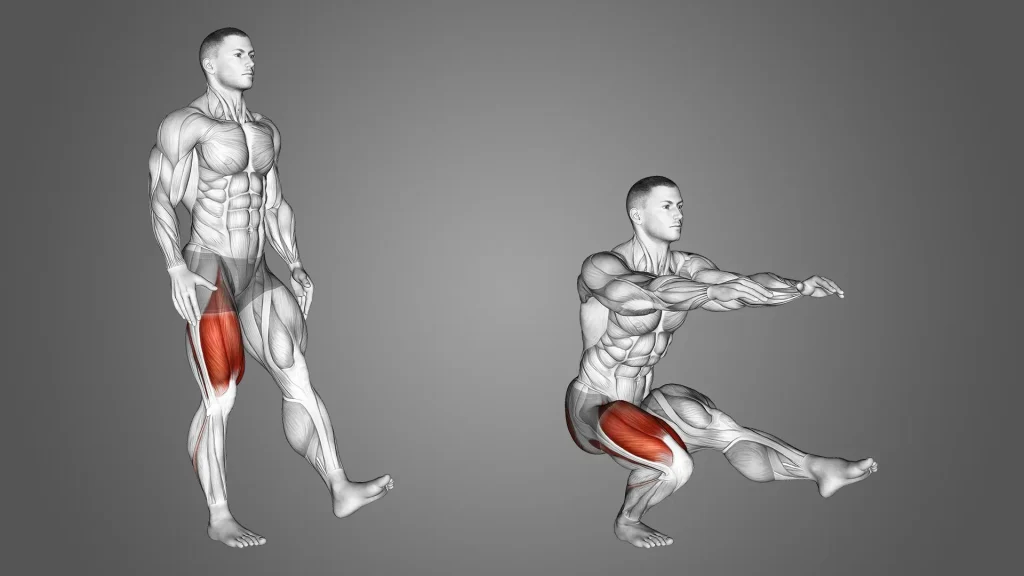The pistol squat is widely regarded as one of the most challenging bodyweight exercises, demanding a remarkable blend of strength, balance, and flexibility. Mastering this single-leg squat not only enhances your lower body power but also contributes to overall functional fitness. To achieve proper pistol squat form, beginners can benefit from meticulous pistol squat progression, which allows them to build the necessary strength and mobility gradually. Many people seek pistol squat tips to refine their technique and prevent injury, making it essential to approach this exercise thoughtfully. By incorporating it into your routine, you can enhance your physical capabilities and impress those around you with your athletic prowess.
Exploring the intricacies of the pistol squat reveals its reputation as a pinnacle of lower body training. This advanced maneuver combines elements of balance, unilateral strength, and agility, elevating the single-leg squat to new heights. Many fitness enthusiasts find themselves drawn to this dynamic movement due to its unique challenge and the impressive results it delivers. As you delve deeper into the nuances of this exercise, utilizing effective progression methods and focusing on achieving optimal form becomes crucial. This foundational approach not only aids in mastering the pistol squat but also enriches your overall workout regimen.
Understanding the Benefits of the Pistol Squat
The pistol squat is not just a visually impressive exercise; it offers a wealth of benefits that enhance overall physical fitness. This single-leg squat builds substantial unilateral strength, meaning it improves the strength of each leg individually. By focusing on one side at a time, you can identify and correct any muscle imbalances that may exist between your legs. Moreover, it improves overall core stability, as the exercise requires significant engagement of the abdominal muscles to maintain balance.
In addition to building strength, the pistol squat offers functional benefits that translate to real-life movements. Increased strength and stability gained from this exercise can improve activities such as running, jumping, and climbing stairs. Furthermore, mastering the pistol squat can enhance your overall athletic performance and reduce the risk of injury by improving joint stability and knee health. With the right progression training, the pistol squat becomes an integral part of a well-rounded bodyweight exercise routine.
Step-by-Step Guide to Pistol Squat Progression
To effectively master the pistol squat, it’s essential to follow a structured progression plan. Begin with foundational exercises such as air squats, focusing on your form and ensuring full range of motion. From there, gradually increase the difficulty by introducing close feet squats and eccentric single-leg squats on a bench. These progressions allow your body to adapt to the movement patterns essential for achieving a proper pistol squat.
As you progress, incorporate single-leg box squats and toe squats into your training regimen. These variations not only target the same muscle groups as the pistol squat but also help improve your balance and coordination. When performing these exercises, aim for controlled movements that emphasize depth and strength. The goal is to build strength through the full motion, ultimately preparing you to execute the full pistol squat with proper form.
Tips for Perfecting Your Pistol Squat Form
Achieving the correct form in a pistol squat is vital for safe and effective execution. Start by ensuring that your planted foot is firmly positioned on the ground and that your ankle, knee, and hip remain aligned throughout the movement. As you lower into the squat, extend your arms forward for added balance. This engages your core and helps maintain stability, which is crucial since you’re balancing on only one leg.
Another key element is to focus on the depth of your squat. Aim to lower your body as far as your flexibility allows while keeping your opposite leg raised and extended in front of you. If you’re unable to reach the bottom position initially, there’s no need to rush. Instead, work on improving your ankle and hip mobility through stretching and other preparatory exercises. With consistent practice and attention to form, you’ll enhance your comfort with the pistol squat and maximize its benefits.
The Importance of Mobility in Pistol Squat Training
Mobility is a critical component when it comes to successfully executing the pistol squat. Tight hips or ankles can severely limit your ability to perform the movement properly and can even lead to injury. Incorporating mobility drills into your warm-up routine can significantly enhance your range of motion and prepare your joints for the demands of the pistol squat. Exercises like the frog stretch and pigeon stretch are particularly effective in loosening tightness in your hips, allowing for a deeper squat.
Implementing regular ankle detection tests, like the knee-to-wall test, helps identify any limitations in your ankle flexibility. If issues arise, dedicating time to ankle mobility drills can improve your performance not just in the pistol squat but also in various other bodyweight exercises. Remember, integrating mobility exercises should become a staple in your training program for long-term benefits.
When to Include the Pistol Squat in Your Workout Plan
Integrating the pistol squat into your workout plan requires strategic timing to reap the most benefits. Initially, focus on mastering other bodyweight exercises and mobility drills for a few weeks. Once you feel confident with your strength and balance, begin to incorporate the pistol squat on leg-focused workout days, ideally aiming for three to four sessions per week.
When first adding pistol squats to your routine, start with lower repetitions and gradually increase as you build confidence and strength. Consider performing 3 sets of 5 reps on each leg, allowing adequate rest between sets to maintain the quality of your form throughout the exercise. This thoughtful approach encourages gradual improvement and ensures that you develop not only strength but also the proper technique critical for executing a flawless pistol squat.
Common Mistakes to Avoid in Pistol Squats
Many individuals struggle with the pistol squat, often leading to major mistakes that can hinder performance and lead to injury. One common mistake is failing to engage the core effectively, which can cause instability and result in a wobbly squat. Always remember to keep your core tight and engaged throughout the movement to maintain balance and control.
Another mistake is rushing into the full pistol squat without proper progression. Skipping the foundational exercises or mobility work can result in poor form and increased risk of injury. Take your time to master each stage of the progression and ensure that you have the requisite strength and mobility. This approach will not only enhance your performance but also ensure your safety in executing this challenging exercise.
Enhancing Balance and Coordination Through Pistol Squats
The pistol squat is an excellent exercise for building balance and coordination. As you shift your weight to one leg, you’ll engage stabilizing muscles that might not get worked in traditional squats. Improved balance translates to better performance in sports and daily activities, enhancing your overall functional fitness. This single-leg movement requires concentration and control, making it an ideal way to refine your body awareness.
To further enhance balance during your pistol squat training, consider incorporating additional exercises that focus on stability. Moves like single-leg deadlifts or yoga poses, such as tree pose, can complement your pistol squat practice. By consistently working on your balance alongside your strength training, you’ll find yourself progressing faster and feeling more confident in your pistol squat and other challenging bodyweight exercises.
Building Functional Strength With Pistol Squats
One of the most significant advantages of the pistol squat is its ability to build functional strength. Unlike traditional weightlifting, which might isolate muscle groups, the pistol squat engages multiple muscle groups all at once, mimicking real-life movements. As you work to lower your body and return to standing, you’re training your body to power through functional tasks, improving your overall strength for everyday movements.
Incorporating pistol squats into your workout not only improves lower body strength but also engages your core and stabilizing muscles, providing comprehensive benefits. This functional strength is particularly beneficial for athletes, as it can enhance overall performance in sports that require power, agility, and stability. Moreover, the strength gained from pistol squats aids in injury prevention, making it an essential addition to any strength training regimen.
The Role of Consistency in Mastering the Pistol Squat
Consistency is key when it comes to mastering the pistol squat. Like any challenging bodyweight exercise, regular practice not only helps improve strength but also enhances technique and form over time. To build the necessary muscle memory, aim for short, consistent training sessions throughout the week, allowing your body to adapt without overtraining.
Set clear goals and monitor your progress to stay motivated. Whether it’s refining your form or successfully lowering yourself deeper, tracking improvements can help maintain enthusiasm. Remember, everyone progresses at their own pace, so focus on your journey, celebrating the small victories as you work toward mastering the pistol squat.
Frequently Asked Questions
What are the key benefits of incorporating the pistol squat into my workout routine?
The pistol squat is an advanced bodyweight exercise that significantly enhances unilateral strength, balance, and mobility. By performing this exercise, you engage multiple muscle groups in the legs while improving coordination and stability, which are essential for athletic performance and everyday activities.
How do I progress from a regular squat to a pistol squat?
To master the pistol squat, it’s important to follow a structured pistol squat progression plan. Start with basic exercises like air squats and close feet squats, then gradually move on to more advanced variations such as eccentric single-leg squats and single-leg box squats, eventually leading to the full pistol squat.
What are some essential tips for maintaining proper pistol squat form?
When performing a pistol squat, ensure that you maintain proper form by picking a base leg, keeping the opposite leg extended in front of you, and pushing your hips back as you lower into the squat. It’s also crucial to engage your core and glutes for stability and to lower to a depth that your mobility allows.
Can I perform pistol squats without prior experience in single-leg exercises?
While the pistol squat is challenging, you can start with bodyweight exercises like air squats and gradually incorporate single-leg squats. It’s advisable to build strength and mobility through specific warm-up and assessment exercises before attempting the full pistol squat.
What kind of warm-up should I do before attempting a pistol squat?
Before performing pistol squats, engage in a proper warm-up that includes ankle and hip mobility drills, such as kneel and lean, leg hugs, and pigeon stretches. These exercises will help improve your range of motion and prepare your muscles for the demands of the pistol squat.
How frequently should I practice the pistol squat to see improvements?
To effectively improve your pistol squat, incorporate practice sessions three to four times per week, focusing on the progressions and mobility drills. Consistent practice, patience, and attention to form will lead to mastery of the movement.
How do I know if I’m ready for a full pistol squat?
You are likely ready for a full pistol squat when you can perform the prescribed progressions with control and good form. Be sure to assess your range of motion and work on maintaining balance while squatting down to your maximum depth comfortably.
What should I do if I experience discomfort while performing pistol squats?
If you experience discomfort or pain while attempting pistol squats, consider consulting a physical therapist or trainer to assess your form and address any underlying issues. Avoid pushing through pain, and focus on mobility and strength-building exercises designed to improve your base before retrying the pistol squat.
Can the pistol squat help improve my overall athletic performance?
Yes, the pistol squat can enhance your athletic performance by developing unilateral leg strength, which is crucial for sports that require balance, agility, and core stability. Incorporating this exercise into your training can lead to improved power and coordination.
Are there any variations of the pistol squat that I can try?
Yes, there are several pistol squat variations, including weighted pistol squats, assisted pistol squats using a support, or performing them on an elevated surface. These variations can help tailor the exercise to your fitness level and strengthen different aspects of the movement.
| Key Point | Details |
|---|---|
| Overview | The pistol squat is a challenging single-leg exercise that requires strength, balance, and mobility. |
| Proper Form | Maintain balance on one leg while properly executing the squat. |
| Step-by-Step Instructions | Includes picking a base leg, balancing with arms, and gradually lowering while maintaining an elevated other leg. |
| Preparation | Conduct ankle and hip assessments, followed by warm-up exercises for both areas. |
| Progression Plan | Start with air squats, then progress through a series of exercises leading up to the full pistol squat. |
| Differences from Regular Squats | Pistol squats require a deeper squat position with the opposite leg extended forward. |
| Implementation | Incorporate mobility drills while progressing and maintain practice three to four times a week. |
Summary
The pistol squat is a highly effective bodyweight exercise that challenges your strength, balance, and mobility. By following a structured progression plan and proper form, you can gradually master this move, reaping benefits for functional fitness and unilateral strength. With dedication and practice, the pistol squat will not only improve your physical abilities but also enhance your overall workout routine.



